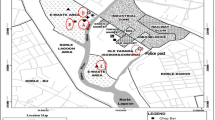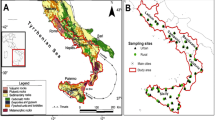Abstract
Detailed composition of chlorinated and brominated polycyclic aromatic hydrocarbons (Cl-PAHs and Br-PAHs) generated during informal recycling of e-waste and their toxic relevance are still poorly understood. This study investigated the occurrence of Cl-PAHs and Br-PAHs in surface soil samples from the Agbogbloshie e-waste recycling site (Accra, Ghana) using quantitative gas chromatography–mass spectrometry (GC–MS) and comprehensive two-dimensional GC–time-of-flight mass spectrometry (GC × GC–ToFMS) profiling. The results of GC–MS analysis showed elevated concentrations in open e-waste burning areas (160–220 and 19–46 ng/g dry weight for Cl- and Br-PAHs, respectively) with substantial contribution from unidentified compounds (respectively, more than 36 and 70%, based on the total areas of potential peaks). Cl- and Br-PAHs from e-waste burning had a distinctive composition dominated by ring–ring compounds. Several homologue groups not monitored with GC–MS were found using GC × GC–ToFMS: PAHs with up to 5Cl or 3Br, mixed halogenated PAHs and chlorinated methylPAHs. The dioxin-like toxic equivalents of the identified Cl-/Br-PAHs in soils, estimated from their in vitro AhR agonist potencies relative to 2,3,7,8-tetrachlorodibenzo-p-dioxin, were much lower than the range reported for chlorinated and brominated dioxins. However, the toxicity of the unidentified halogenated PAHs remained unclear.



Similar content being viewed by others
References
Balde CP, Wang F, Kuehr R, Huisman J (2015) The global e-waste monitor—2014. United Nations University, IAW-SCYCLE, Bonn
Brigden K, Labunska I, Santillo D, Allsopp M (2005) Recycling of electronic wastes in China and India: workplace and environmental contamination. Greenpeace Research Laboratories, University of Exeter, UK. http://www.greenpeace.org/international/PageFiles/25134/recycling-of-electronic-waste.pdf. Accessed 20 Jul 2016
Terazono A, Murakami S, Abe N, Inanc B, Moriguchi Y, Sakai S, Kojima M, Yoshida A, Li J, Yang J, Wong MH, Jain A, Kim I, Peralta G, Lin C, Mungcharoen T, Williams E (2006) Current status and research on e-waste issues in Asia. J Mater Cycles Waste Manag 8:1–12. doi:10.1007/s10163-005-0147-0
Schluep M, Manhart A, Osibanjo O, Rochat D, Isarin N, Mueller E (2011) Where are WEee in Africa? Findings from the Basel Convention E-waste Africa Programme. http://www.basel.int/Portals/4/download.aspx?d=UNEP-CHW-EWASTE-PUB-WeeAfricaReport.English.pdf. Accessed 20 Jul 2016
Amoyaw-Osei Y, Agyekum O, Pwamang J, Mueller E, Fasko R, Schluep M (2011) Ghana e-Waste Country Assessment. SBC e-Waste Africa Project. http://www.basel.int/Portals/4/Basel%20Convention/docs/eWaste/E-wasteAssessmentGhana.pdf. Accessed 20 Jul 2016
Robinson BH (2009) E-waste: an assessment of global production and environmental impacts. Sci Total Environ 408:183–191. doi:10.1016/j.scitotenv.2009.09.044
Watson A, Bridgen K, Shinn M, Cobbing M (2010) Toxic transformers—a review of the hazards of brominated and chlorinated substances in electrical and electronic equipment. Greenpeace Research Laboratories, Technical Note 01/2010. http://www.greenpeace.to/publications/Toxic-Transformers-2010.pdf. Accessed 20 Jul 2016
Chan JKY, Wong MH (2013) A review of environmental fate, body burdens, and human health risk assessment of PCDD/Fs at two typical electronic waste recycling sites in China. Sci Total Environ 463–464:1111–1123. doi:10.1016/j.scitotenv.2012.07.098
Tue NM, Takahashi S, Subramanian A, Sakai S, Tanabe S (2013) Environmental contamination and human exposure to dioxin-related compounds in e-waste recycling sites of developing countries. Environ Sci Process Impacts 15:1326–1331. doi:10.1039/C3EM00086A
Wang D, Xu X, Chu S, Zhang D (2003) Analysis and structure prediction of chlorinated polycyclic aromatic hydrocarbons released from combustion of polyvinylchloride. Chemosphere 53:495–503. doi:10.1016/S0045-6535(03)00507-1
Nilsson UL, Östman CE (1993) Chlorinated polycyclic aromatic hydrocarbons: method of analysis and their occurrence in urban air. Environ Sci Technol 27:1826–1831. doi:10.1021/es00046a010
Koistinen J, PaasivirtaJ Nevalainen T, Lahtiperä M (1994) Chlorinated fluorenes and alkylfluorenes in bleached kraft pulp and pulp mill discharges. Chemosphere 28:2139–2150. doi:10.1016/0045-6535(94)90182-1
Grause G, Karakita D, Ishibashi J, Kameda T, Bhaskar T, Yoshioka T (2011) TG–MS investigation of brominated products from the degradation of brominated flame retardants in high-impact polystyrene. Chemosphere 85:368–373. doi:10.1016/j.chemosphere.2011.06.104
Yoshino H, Urano K (1997) Formation of chlorinated PAHs in exhaust gas from municipal waste incinerators, and their mutagenic activities. Toxicol Environ Chem 63:233–246. doi:10.1080/02772249709358533
Horii Y, Ok G, Ohura T, Kannan K (2008) Occurrence and profiles of chlorinated and brominated polycyclic aromatic hydrocarbons in waste incinerators. Environ Sci Technol 42:1904–1909. doi:10.1021/es703001f
Ohura T, Morita M, Makino M, Amagai T, Shimoi K (2007) Aryl hydrocarbon receptor-mediated effects of chlorinated polycyclic aromatic hydrocarbons. Chem Res Toxicol 20:1237–1241. doi:10.1021/tx700148b
Horii Y, Khim JS, Higley EB, Giesy JP, Ohura T, Kannan K (2009) Relative potencies of individual chlorinated and brominated polycyclic aromatic hydrocarbons for induction of aryl hydrocarbon receptor-mediated responses. Environ Sci Technol 43:2159–2165. doi:10.1021/es8030402
Ma J, Horii Y, Cheng J, Wang W, Wu Q, Ohura T, Kannan K (2009) Chlorinated and parent polycyclic aromatic hydrocarbons in environmental samples from an electronic waste recycling facility and a chemical industrial complex in China. Environ Sci Technol 43:643–649. doi:10.1021/es802878w
Ieda T, Ochiai N, Miyawaki T, Ohura T, Horii Y (2011) Environmental analysis of chlorinated and brominated polycyclic aromatic hydrocarbons by comprehensive two-dimensional gas chromatography coupled to high-resolution time-of-flight mass spectrometry. J Chromatogr A 1218:3224–3232. doi:10.1016/j.chroma.2011.01.013
Tue NM, Goto A, Takahashi S, Itai T, Asante KA, Kunisue T, Tanabe S (2016) Release of chlorinated, brominated and mixed halogenated dioxin-related compounds to soils from open burning of e-waste in Agbogbloshie (Accra, Ghana). J Hazard Mater 302:151–157. doi:10.1016/j.jhazmat.2015.09.062
Itai T, Otsuka M, Asante KA, Muto M, Opoku-Ankomah Y, Ansa-Asare OD, Tanabe S (2014) Variation and distribution of metals and metalloids in soil/ash mixtures from Agbogbloshie e-waste recycling site in Accra, Ghana. Sci Total Environ 470–471:707–716. doi:10.1016/j.scitotenv.2013.10.037
Tue NM, Suzuki G, Takahashi S, Isobe T, Trang PTK, Viet PH, Tanabe S (2010) Evaluation of dioxin-like activities in settled house dust from Vietnamese e-waste recycling sites: relevance of polychlorinated/brominated dibenzo-p-dioxin/furans and dioxin-like PCBs. Environ Sci Technol 44:9195–9200. doi:10.1021/es102505j
Tuyen LH, Tue NM, Suzuki G, Misaki K, Viet PH, Takahashi S, Tanabe S (2014) Aryl hydrocarbon receptor mediated activities in road dust from a metropolitan area, Hanoi—Vietnam: contribution of polycyclic aromatic hydrocarbons (PAHs) and human risk assessment. Sci Total Environ 491–492:246–254. doi:10.1016/j.scitotenv.2014.01.086
Horii Y, Ohura T, Yamashita N, Kannan K (2009) Chlorinated polycyclic aromatic hydrocarbons in sediments from industrial areas in Japan and the US. Arch Environ Contam Toxicol 57:651–660. doi:10.1007/s00244-009-9372-1
Ni HG, Zeng EY (2012) Environmental and human exposure to soil chlorinated and brominated polycyclic aromatic hydrocarbons in an urbanized region. Environ Toxicol Chem 31:1494–1500. doi:10.1002/etc.1854
Ma J, Zheng J, Chen Z, Wu M, Horii Y, Ohura T, Kannan K (2012) Chlorinated polycyclic aromatic hydrocarbons in urban surface dust and soil of Shanghai, China. Adv Mat Res 610–613:2989–2994. doi:10.4028/www.scientific.net/AMR.610-613.2989
Ohura T, Fujima S, Amagai T, Shinomiya M (2008) Chlorinated polycyclic aromatic hydrocarbons in the atmosphere: seasonal levels, gas–particle partitioning, and origin. Environ Sci Technol 42:3296–3302. doi:10.1021/es703068n
Ma J, Chen Z, Wu M, Feng J, Horii Y, Ohura T, Kannan K (2013) Airborne PM2.5/PM10-associated chlorinated polycyclic aromatic hydrocarbons and their parent compounds in a suburban area in Shanghai, China. Environ Sci Technol 47:7615–7623. doi:10.021/es400338h
Ohura T, Sawada K, Amagai T, Shinomiya M (2009) Discovery of novel halogenated polycyclic aromatic hydrocarbons in urban particulate matters: occurrence, photostability, and AhR activity. Environ Sci Technol 43:2269–2275. doi:10.1021/es803633d
Tuyen LH, Tue NM, Takahashi S, Suzuki G, Viet PH, Subramanian A, Bulbule KA, Parthasarathy P, Ramanathan A, Tanabe S (2014) Methylated and unsubstituted polycyclic aromatic hydrocarbons in street dust from Vietnam and India: occurrence, distribution and in vitro toxicity evaluation. Environ Pollut 194:272–280. doi:10.1016/j.envpol.2014.07.029
van den Berg M, Birnbaum LS, Denison M, De Vito M, Farland W, Feeley M, Fiedler H, Hakansson H, Hanberg A, Haws L, Rose M, Safe S, Schrenk D, Tohyama C, Tritscher A, Tuomisto J, Tysklind M, Walker N, Peterson RE (2006) The 2005 World Health Organization reevaluation of human and mammalian toxic equivalency factors for dioxins and dioxin-like compounds. Toxicol Sci 93:223–241. doi:10.1093/toxsci/kfl055
Sjögren M, Ehrenberg L, Rannug U (1996) Relevance of different biological assays in assessing initiating and promoting properties of polycyclic aromatic hydrocarbons with respect to carcinogenic potency. Mutat Res 358:97–112. doi:10.1016/0027-5107(96)00175-3
Behnisch PA, Hosoe K, Sakai S (2003) Brominated dioxin-like compounds: in vitro assessment in comparison to classical dioxin-like compounds and other polyaromatic compounds. Environ Int 29:861–877. doi:10.1016/S0160-4120(03)00105-3
Colmsjö A, Rannug A, Rannug U (1984) Some chloro derivatives of polynuclear aromatic hydrocarbons are potent mutagens in Salmonella typhimurium. Mutat Res Genet Toxicol 135:21–29. doi:10.1016/0165-1218(84)90144-7
Löfroth G, Nilsson L, Agurell E, Sugiyama T (1985) Salmonella/microsome mutagenicity of monochloro derivatives of some di-, tri- and tetracyclic aromatic hydrocarbons. Mutat Res Genet Toxicol 155:91–94. doi:10.1016/0165-1218(85)90123-5
Acknowledgements
The authors thank M. Muto (Ehime University) and CSIR Water Research Institute staff for their assistance during the sampling survey. We also thank Dr Ohura (Meijo University, Japan) for providing the Cl-PAH standards and Dr Sankoda (Kumamoto University, Japan) for preparing the Cl-PAH standard solution. This study was supported in part by Grants-in-Aid for Scientific Research (A: 25257403, A: 16H01784 and B: 16H02963) from the Japan Society for the Promotion of Science (JSPS) and the Environment Research and Technology Development Fund (3K153001) from the Japanese Ministry of the Environment.
Author information
Authors and Affiliations
Corresponding author
Rights and permissions
About this article
Cite this article
Tue, N.M., Goto, A., Takahashi, S. et al. Soil contamination by halogenated polycyclic aromatic hydrocarbons from open burning of e-waste in Agbogbloshie (Accra, Ghana). J Mater Cycles Waste Manag 19, 1324–1332 (2017). https://doi.org/10.1007/s10163-016-0568-y
Received:
Accepted:
Published:
Issue Date:
DOI: https://doi.org/10.1007/s10163-016-0568-y




